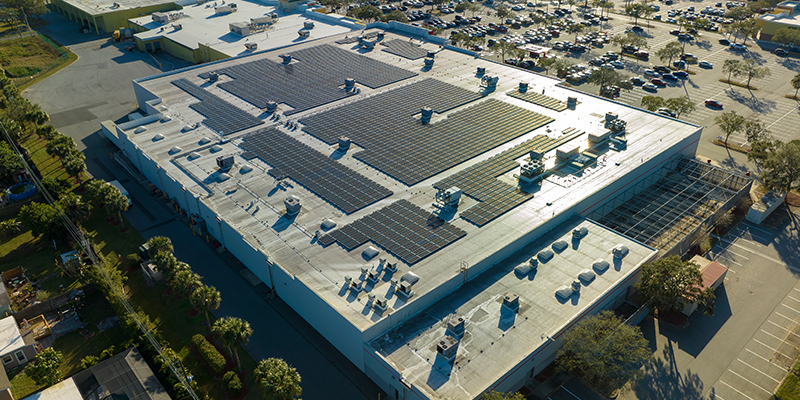By Marie Ruff
Knowing that the markets hate uncertainty, how can industrial investors, owners and developers make wise decisions during a period marked by global trade wars and other wide-ranging geopolitical forces? A panel of experts at NAIOP’s I.CON East this week in Jersey City, New Jersey, shared their perspectives on opportunities and risks facing the industrial capital markets and the critical factors to consider in the year ahead. The panel was moderated by Erik Foster, CCIM, leader for U.S. Industrial Capital Markets, and principal of the Capital Markets Executive Committee at Avison Young.
Joining Foster were PJ Charlton, executive vice president, head of East Region, CenterPoint Properties; Tom Fishman, executive vice president, acquisitions and dispositions, Hillwood; Brandi Hanback, executive vice president, head of development, Rockefeller Group; and Michael Neuman, managing director, real estate, CDPQ.
Compared to other asset classes, Foster said, industrial is doing well, referencing a chart of U.S. National Council of Real Estate Investment Fiduciaries’ Property Index quarterly returns. He noted that while the COVID-19 pandemic era boasted exceptionally high returns for industrial, now “we seem to be stabilizing.”
Turning to compounded annual rent growth for select markets, Foster noted that most of the markets analyzed are positive, including some secondary markets like Nashville. Notable exceptions include the Inland Empire; Indianapolis; Columbus, Ohio; and Las Vegas.
“Before the great financial crisis and even before the [COVID-19] pandemic, 2-3% was [a typical] annual growth rate,” Foster said, “But now 3% and 4% is not unheard of, and we’re seeing that happen in a lot of leasing.”
“I think of our platform and what we’re seeing in leasing and supply challenges, specifically in the Inland Empire,” Hanback said. “A lot of it is due to supply but also indecision and paralysis on the corporate side.”
“We’re developing but taking a little bit more of a cautious approach,” Hanback said. “We’re still bullish longer term but we recognize that absorption is going to take some time to level out.”
Neuman shared his international perspective on investments in U.S. industrial. Based in Montreal, Neuman oversees transactions for all asset types and sectors in the U.S. for Ivanhoé Cambridge, CDPQ’s real estate portfolio.
“We’re investing less and being more cautious,” Neuman said. “We’re also looking for more opportunities to slow down. We’re trying to steer toward more value-add as well and taking risks in very specific areas where we know there are lower supply and lower vacancies.”
“Times have changed, but we’re still very optimistic about industrial,” said Charlton. “I think this is part of normalization, getting back to basics.”
“You know, there were 500 [million square feet] or 600 million square feet built two years in a row in our sector. That’s a lot of space,” Charlton said. “It feels like we’re leveling off.”
“We’re developing a lot less, but we see opportunities on the acquisition side,” Fishman added. “You take care of your customers or your tenants, and manage these assets to maximize value in other ways than just lower cap rates. You still see rent increases so you can see value there.”
Overall leasing and build-to-suits are slower, but they can add value to a company and try to move them from a 32-foot-clear building into a 40-foot-clear building, he added.
The panelists noted that opportunities right now can often be market- (or even submarket-) and building- specific, with several panelists mentioning challenges on the West Coast, particularly in California, as well as challenges trading Class B properties.
A 200,000-square-foot Class A building in Carson, California, with infill trailer parking and 40-foot-clear heights would have been 100% pre-leased at high rent rates a few years ago but is now sitting vacant instead. Meanwhile, “We signed a one-million-square-foot lease on a brand-new building in Joliet, Illinois,” said Charlton. “It’s very market specific. There are certain markets where the big box is slow.”
“You really have to do your homework to know where to invest and where to develop,” added Fishman.
“Decorrelating from China and Asia is going to take ages, maybe more than a decade, and you can’t bet against Inland Empire in the long run, given the people living there, but also the importance of this hub for international trade for the U.S.,” Neuman said.
“We remain convinced that in the long run, the Inland Empire is still a place to grow and a place to create those big assets; just not right now,” Neuman said.
“I sit in our Annapolis office where our Foreign Trade Zone division and trading consulting group sits, and I came from that world,” said Hanback. “So, I get to see the conversations that are happening in real time with importers and distributors and manufacturers. I think they’re trying to ‘Band-Aid’ in the short term and get a sense of what stability and foresight looks like for tariff policy down the road.”
“There’s a lot of demand for companies trying to get some control, some insurance policy, some flexibility so that they can plan to ensure their shipping, orders, and overseas factories can be planned and flow,” she said.
“When we go into an investment committee, we explain that we’re pretty bullish about our five-year plan, and that’s really difficult given the volatility of the last five years and that we’re currently going through right now,” Neuman said. “It’s difficult to convince yourself when you hear the tenants who are themselves uncertain.”

This post is brought to you by JLL, the social media and conference blog sponsor of NAIOP’s I.CON East 2025. Learn more about JLL at www.us.jll.com or www.jll.ca.








